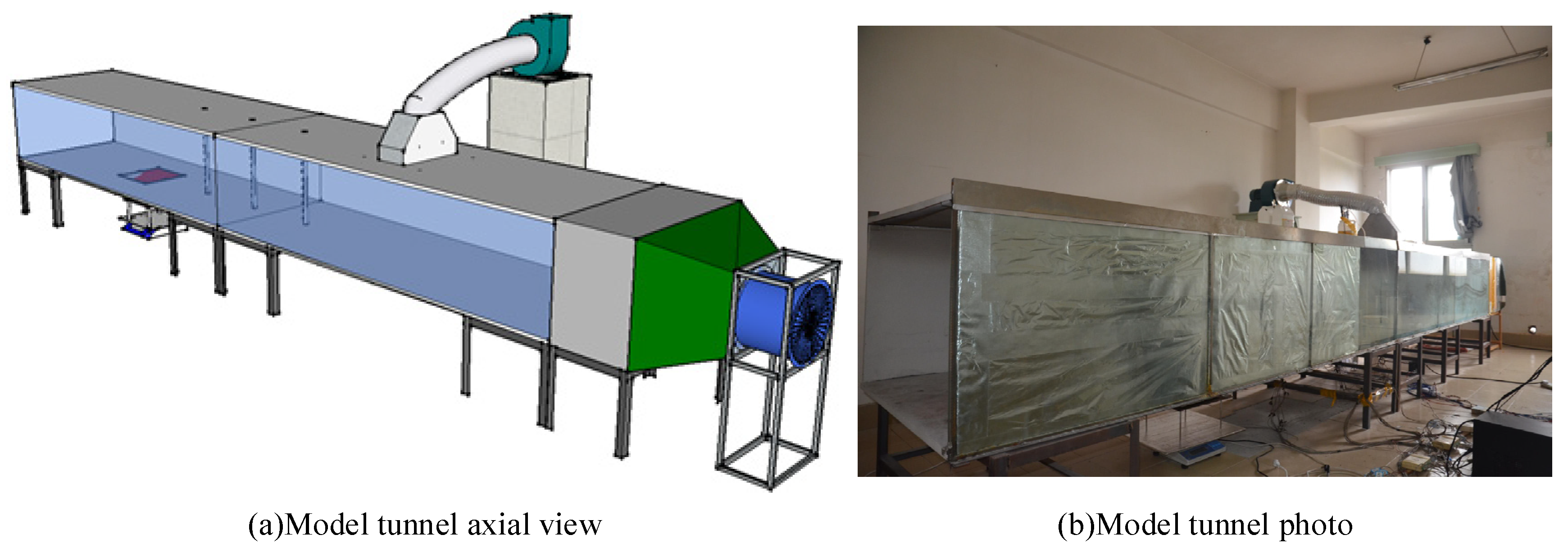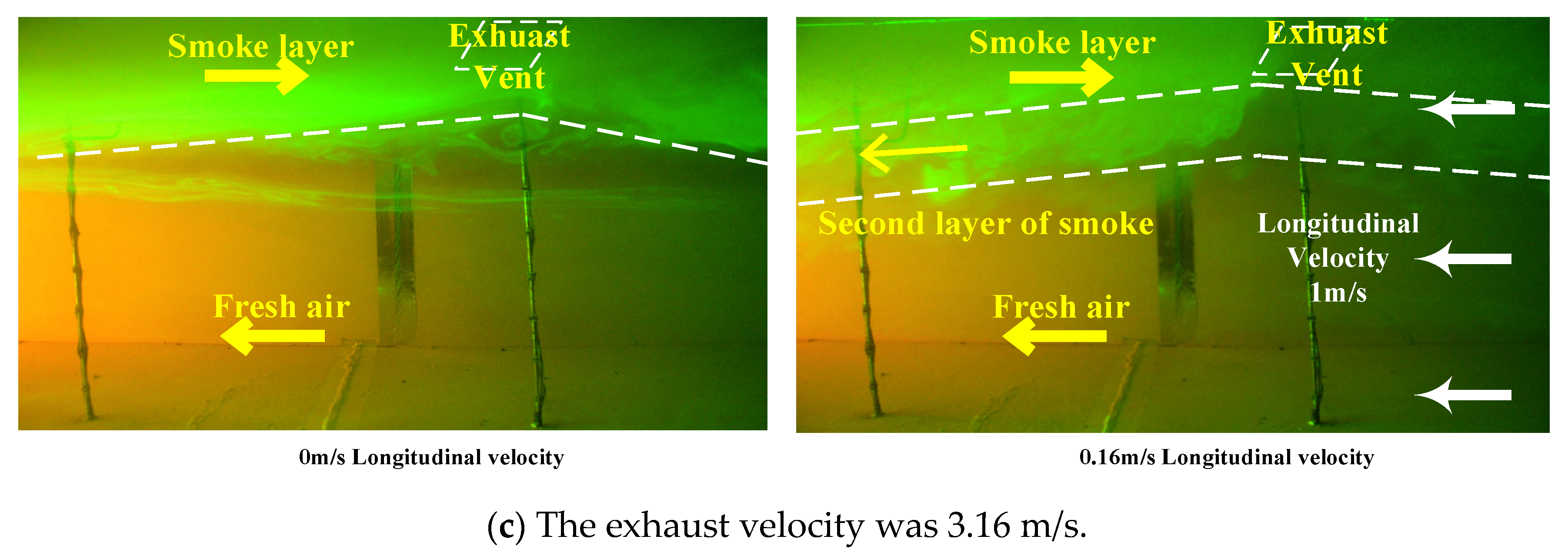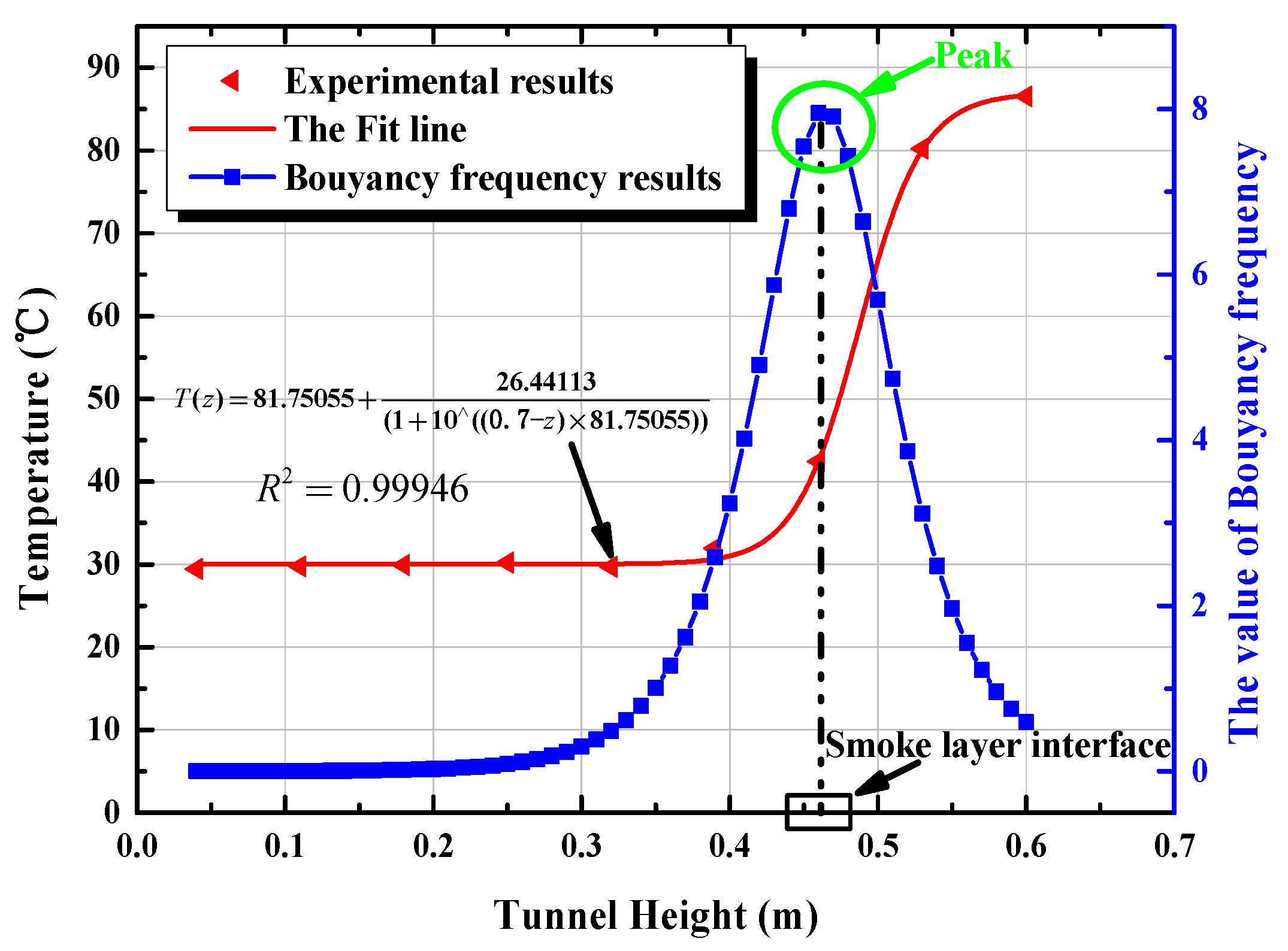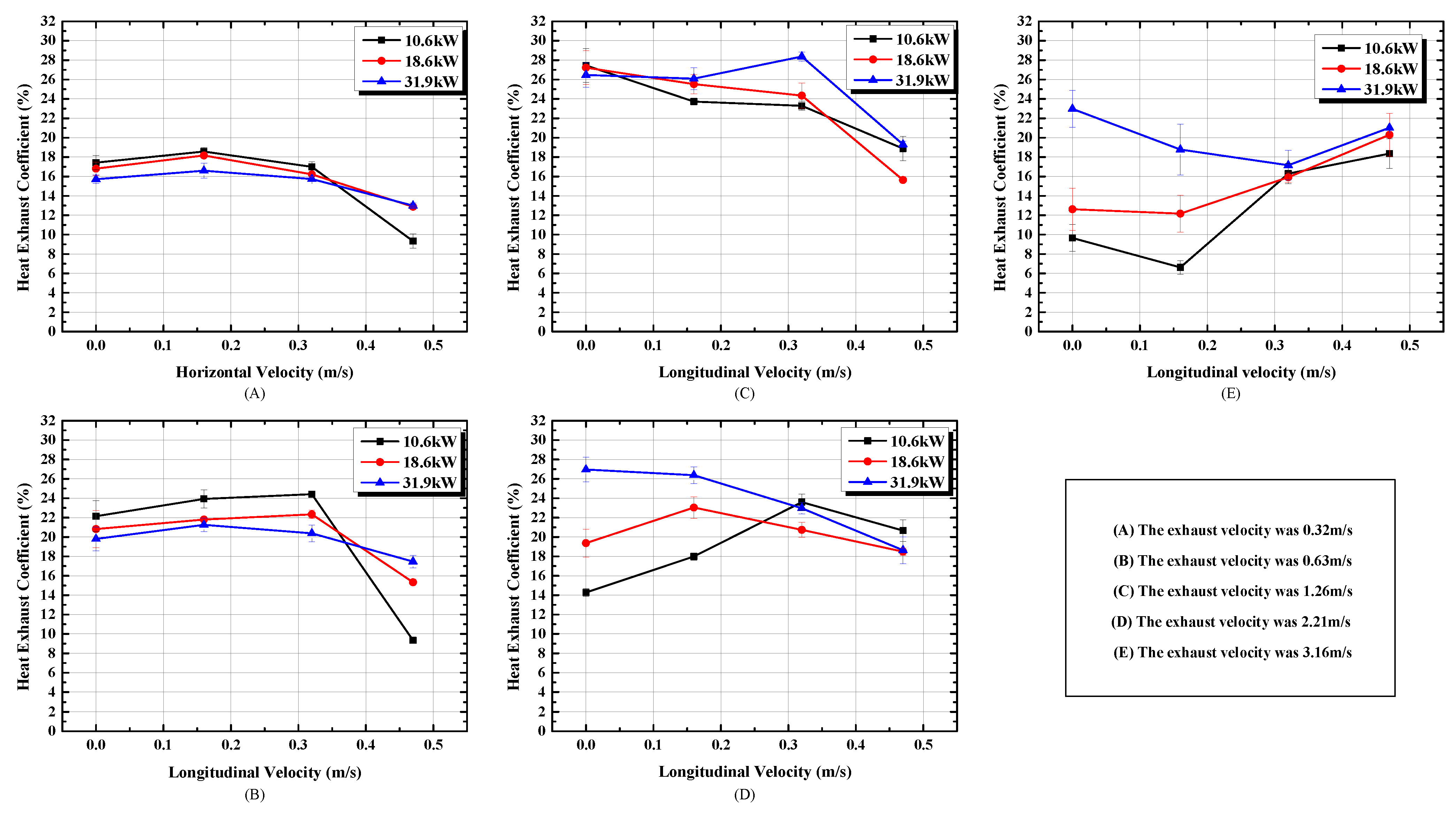Experimental Investigation on the Discharge of Pollutants from Tunnel Fires
Abstract
1. Introduction
2. Experimental Setup
2.1. Experimental Rigs
2.2. Measurement
2.3. Experimental Procedure
3. Results and Discussion
Buoyant Flow Stratification Regimes Visualizations
4. Smoke Layer Height Changes
Heat Exhaust Coefficient Change
5. Conclusions
- (1)
- Secondary stratification of smoke caused by longitudinal wind was observed in experimental phenomena.
- (2)
- At the interface of the two smoke layers, there were both vortex and air entrainment, and the thickness of the overall smoke layer became larger. At the same time, the increase of the exhaust velocity was observed, and the area of the recessed area below the exhaust vent was enlarged, and the longitudinal wind reduced the area of the recessed area at the exhaust vent to a certain extent.
- (3)
- In the ceiling extract tunnel under longitudinal ventilation, considering the research results of the smoke layer height and the heat exhaust coefficient, a better scheme for fire-producing pollutants was that the exhaust velocity should be 1.26–2.21 m/s (corresponding to the actual velocity of 4.0–7.0 m/s). The longitudinal velocity should be 0.16–0.32 m/s (corresponding to the actual velocity of 0.5–1.0 m/s).
Author Contributions
Funding
Conflicts of Interest
Nomenclature
| Greek symbols | |||
| heat release rate (kW) | l | oscillating distance | |
| Ta | ambient air temperature (°C) | Δ | deviation property |
| Ti | smoke layer interface temperature (°C) | Ρ | density (kg/m3) |
| Tmax | maximum temperature of vertical distribution (°C) | δ | partial derivative |
| NL | smoke layer height (m) | Subscripts | |
| H | tunnel height (m) | S | smoke |
| T(Z) | vertical temperature distribution function | A | ambient air |
| g | gravitational acceleration (m/s2) | I | interface |
| ΔH | combustion heat of absolute anhydrous ethanol (kJ/g) | P | plume |
| F | fire | ||
References
- Wen, T.; Hu, L.H. Review of research on fire prevention of traffic tunnel. China Publ. Secur. 2010, 3, 41–44. [Google Scholar]
- Ministry of Transport of the People’s Republic of China. 2018 Transportation Industry Development Statistics Bulletin. Available online: http://xxgk.mot.gov.cn/jigou/zhghs/201904/t20190412_3186720.html (accessed on 28 February 2019).
- Ren, R.; Zhou, H.; Hu, Z.; He, S.Y.; Wang, X.L. Statistical analysis of fire accidents in Chinese highway tunnels 2000–2016. Tunn. Undergr. Space Technol. 2019, 83, 452–460. [Google Scholar] [CrossRef]
- Bechtel, P.B. Memorial Tunnel Fire Ventilation Test Program; Test Report; Massachusetts Highway Department: Boston, MA, USA, 1995. [Google Scholar]
- Vauquelin, O.; Mégret, O. Smoke extraction experiments in case of fire in a tunnel. Fire Saf. J. 2002, 37, 525–533. [Google Scholar] [CrossRef]
- Tang, F.; Cao, Z.L.; Chen, Q.; Meng, N.; Wang, Q.; Fan, C.G. Effect of blockage-heat source distance on maximum temperature of buoyancy-induced smoke flow beneath ceiling in a longitudinal ventilated tunnel. Int. J. Heat Mass Tran. 2017, 109, 683–688. [Google Scholar] [CrossRef]
- Huang, Y.B.; Li, Y.F.; Dong, B.Y.; Bi, Q.; Li, Y.; Li, J.X. Experimental investigation on temperature profile with downstream vehicle in a longitudinally ventilated tunnel. Exp. Ther. Fluid Sci. 2019, 103, 149–156. [Google Scholar] [CrossRef]
- Altay, M.; Surmen, A. Effect of the relative positions of vehicular blockage on the smoke flow behaviour in a scaled tunnel. Fuel 2019, 115694. [Google Scholar] [CrossRef]
- Wu, D.X.; Xu, Z.S.; Li, W.P. Fire Smoke Control in Road Tunnels-Research on Multi-Point Smoke Extraction System with Special Exhaust Duct; China Communications Press Co.: Beijing, China, 2013. [Google Scholar]
- Wu, D.X.; Li, W.P.; Zheng, G.P. Experimental study on concentration model of concentrated smoke exhaust in independent exhaust flue of highway tunnel. Highway 2011, 8, 307–311. [Google Scholar]
- Peng, J.Z.; Xu, Z.S.; Ni, T.X.; Wu, D.X.; Li, W.P. Numerical simulation study on system velocity distribution law of central exhaust mode in highway tunnel. J. Disas. Prev. Mitig. Eng. 2011, 31, 415–422. [Google Scholar]
- Jiang, X.P.; Li, X.J.; Chen, S.; Wang, J.; Zhang, S.G. An experimental study on plug-holing in tunnel fire with central smoke extraction. Appl. Therm. Eng. 2018, 138, 840–848. [Google Scholar] [CrossRef]
- Jiang, X.P.; Zhang, S.Y.; Xu, Z.S.; Wei, D. Effect of different exhaust rates on fire smoke control in a shield tunnel. Sci. Technol. Rev. 2012, 30, 40–44. [Google Scholar]
- Xu, Z.S.; Yu, N.H.; Zhang, X.; Jiang, X.P.; Zhao, H.L.; Li, W.P. Study on induced velocity of highway tunnel entrance fire in centralized smoke exhaust mode. J. Catastr. 2012, 27, 97–101. [Google Scholar]
- Vianelloa, C.; Fabianob, B.; Palazzib, E.; Maschioa, G. Experimental study on thermal and toxic hazards connected tofire scenariosin road tunnels. J. Loss Prev. Process. Ind. 2012, 25, 718–729. [Google Scholar] [CrossRef]
- Zhu, H.H.; Shen, Y.; Yan, Z.G.; Guo, Q.C.; Guo, Q.H. A numerical study on the feasibility and efficiency of point smoke extraction strategies in large cross-section shield tunnel fires using CFD modeling. J. Loss Prev. Process. Ind. 2016, 44, 158–170. [Google Scholar] [CrossRef]
- Chaabata, F.; Salizzonia, P.; Creysselsa, M.; Mosb, A.; Wingravec, J.; Correiaa, H.; Marroa, M. Smoke control in tunnel with a transverse ventilation system: An experimental study. Build. Environ. 2020, 167, 106480. [Google Scholar] [CrossRef]
- Ji, J.; Li, K.Y.; Zhong, W.; Huo, R. Experimental investigation on influence of smoke venting velocity and vent height on mechanical smoke exhaust efficiency. J. Hazard. Mater. 2010, 177, 209–215. [Google Scholar] [CrossRef]
- Fan, C.G.; Ji, J.; Gao, Z.H.; Han, J.Y.; Sun, J.H. Experimental study of air entrainment mode with natural ventilation using shafts in road tunnel fires. Int. J. Heat Mass Transf. 2013, 56, 750–757. [Google Scholar] [CrossRef]
- Fan, C.; Zhang, L.; Jiao, S.; Yang, Z.; Li, M.; Liu, X. Smoke spread characteristics inside a tunnel with natural ventilation under a strong environmental wind. Tunn. Undergr. Space Technol. 2018, 82, 99–110. [Google Scholar] [CrossRef]
- Wang, Y.F.; Jiang, J.C.; Zhu, D.Z. Full-scale experiment research and theoretical study for fires in tunnels with roof openings. Fire Saf. J. 2018, 44, 339–348. [Google Scholar] [CrossRef]
- Ji, J.; Gao, Z.H.; Fan, C.G.; Zhong, W.; Sun, J.H. A study of the effect of plug-holing and boundary layer separation on natural ventilation with vertical shaft in urban road tunnel fires. Int. J. Heat Mass Transf. 2012, 55, 6032–6041. [Google Scholar] [CrossRef]
- Yuan, Z.Y.; Lei, B.; Kashef, A. Experimental and theoretical study for tunnel fires with natural ventilation. Fire Tech. 2015, 51, 691–706. [Google Scholar] [CrossRef]
- Tanaka, F.S.; Majima, S.H.; Kato, M.; Kawabata, N. Performance validation of a hybrid ventilation strategy comprising longitudinal and point ventilation by a fire experiment using a model-scale tunnel. Fire Saf. J. 2015, 71, 287–298. [Google Scholar] [CrossRef]
- Xu, L.; Zhang, X. CFD analysis on induced velocity of horizontal tunnel exhaust using central smoke extraction system. Chin. J. Undergr. Space Eng. 2007, 3, 555–558. [Google Scholar]
- Xu, Z.S.; Zhao, D.; Zhang, X.; Wang, S. Numerical study on effects of induced velocity on central extraction system in large tunnel fire. Procedia Eng. 2012, 45, 678–684. [Google Scholar]
- Wang, G.; Zhao, D. Numerical simulation on impact of induced velocity of single-point extraction system on smoke in large tunnel fire. J. Saf. Environ. 2013, 13, 165–169. [Google Scholar]
- Wu, C.; Ni, T.X.; Xu, Z.S.; Wu, D.X.; Li, W.P. Experimental study on the heat exhausting efficiency under central exhaust mode prone to tunnel fire. J. Saf. Environ. 2013, 13, 156–160. [Google Scholar]
- Yi, L.; Wei, R.; Peng, J.Z.; Ni, T.X.; Xu, Z.S.; Wu, D.X. Experimental study on heat exhaust coefficient of transversal smoke extraction system in tunnel under fire. Tunn. Undergr. Space Technol. 2015, 49, 268–278. [Google Scholar] [CrossRef]
- Zhou, Y.; Bu, R.W.; Gong, J.H.; Yan, W.G.; Fan, C.G. Experimental investigation on downward flame spread over rigid polyurethane and extruded polystyrene foams. Exp. Therm. Fluid Sci. 2018, 92, 346–352. [Google Scholar] [CrossRef]
- Li, Y.Z.; Fan, C.G.; Ingason, H.; Lönnermark, A.; Ji, J. Effect of cross section and ventilation on heat release rates in tunnel fires. Tunn. Undergr. Space Technol. 2016, 51, 414–423. [Google Scholar] [CrossRef]
- Xu, Z.S.; Zhao, J.M.; Liu, Q.L.; Chen, H.G.; Liu, Y.H.; Geng, Z.Y.; He, L. Experimental investigation on smoke spread characteristics and smoke layer height in tunnels. Fire Mater. 2019, 43, 303–309. [Google Scholar] [CrossRef]
- Gao, Z.H.; Ji, J.; Wan, H.X.; Zhu, J.P.; Sun, J.H. Experimental investigation on transverse ceiling flame length and temperature distribution of sidewall confined tunnel fire. Fire Saf. J. 2017, 91, 371–379. [Google Scholar] [CrossRef]
- He, L.; Xu, Z.S.; Chen, H.G.; Liu, Q.L.; Wang, Y.X.; Zhou, Y. Analysis of entrainment phenomenon near mechanical exhaust vent and a prediction model for smoke temperature in tunnel fire. Tunn. Undergr. Space Technol. 2018, 80, 143–150. [Google Scholar] [CrossRef]
- Turner, J.S. Turbulent entrainment: The development of the entrainment assumption, and its application to geophysical flows. J. Fluid Mech. 2006, 173, 431–471. [Google Scholar] [CrossRef]
- Strang, E. Entrainment and mixing in stratified shear flows. J. Fluid Mech. 2001, 428, 3284. [Google Scholar] [CrossRef]
- Quintiere, J.G. Fundamentals of Fire Phenomena; John Wiley and Sons: New York, NY, USA, 2006; p. 223. [Google Scholar]
- Takeuchi, S.; Tanaka, F.; Yoshida, K.; Moinuddin, K. Effects of scale ratio and aspect ratio in predicting the longitudinal smoke temperature distribution during a fire in a road tunnel with vertical shafts. Tunn. Undergr. Space Technol. 2018, 80, 78–91. [Google Scholar] [CrossRef]
- Takeuchi, S.; Aoki, T.; Tanaka, F.; Moinuddin, K.A.M. Modeling for predicting the temperature distribution of smoke during a fire in an underground road tunnel with vertical shafts. Fire Saf. J. 2017, 91, 312–319. [Google Scholar] [CrossRef]









| Test Series | Heat Release Rate (kW) | Exhaust Velocity (m/s) | Longitudinal Velocity (m/s) |
|---|---|---|---|
| V1–V20 | 10.6 | 0.32, 0.63, 1.26, 2.21, 3.16 | 0, 0.16, 0.32, 0.47 |
| V21–V40 | 18.6 | 0.32, 0.63, 1.26, 2.21, 3.16 | 0, 0.16, 0.32, 0.47 |
| V41–V60 | 31.9 | 0.32, 0.63, 1.26, 2.21, 3.16 | 0, 0.16, 0.32, 0.47 |
© 2020 by the authors. Licensee MDPI, Basel, Switzerland. This article is an open access article distributed under the terms and conditions of the Creative Commons Attribution (CC BY) license (http://creativecommons.org/licenses/by/4.0/).
Share and Cite
Zhai, L.; Nong, Z.; He, G.; Xie, B.; Xu, Z.; Zhao, J. Experimental Investigation on the Discharge of Pollutants from Tunnel Fires. Sustainability 2020, 12, 1817. https://doi.org/10.3390/su12051817
Zhai L, Nong Z, He G, Xie B, Xu Z, Zhao J. Experimental Investigation on the Discharge of Pollutants from Tunnel Fires. Sustainability. 2020; 12(5):1817. https://doi.org/10.3390/su12051817
Chicago/Turabian StyleZhai, Lihua, Zhongxing Nong, Guanhong He, Baochao Xie, Zhisheng Xu, and Jiaming Zhao. 2020. "Experimental Investigation on the Discharge of Pollutants from Tunnel Fires" Sustainability 12, no. 5: 1817. https://doi.org/10.3390/su12051817
APA StyleZhai, L., Nong, Z., He, G., Xie, B., Xu, Z., & Zhao, J. (2020). Experimental Investigation on the Discharge of Pollutants from Tunnel Fires. Sustainability, 12(5), 1817. https://doi.org/10.3390/su12051817





